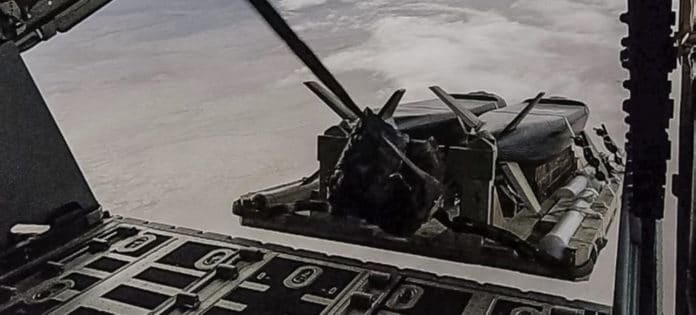The U.S. Air Force Special Operations Command (AFSOC), in conjunction with the Air Force Research Laboratory, has conducted the first tests designed to demonstrate a new combat method: dropping cruise missiles from a transport aircraft. During the tests, the Air Force successfully released simulated palletized munitions in three airdrops at Dugway Proving Ground, Utah, on January 28, 2020. The missile models were dropped from an MC-130J Commando II, a multi-mission, combat, transport, and special operations tanker.
Over the past few years, the U.S. Air Force has been considering the concept of an “Arsenal Plane,” which provides the possibility of creating an aircraft capable of carrying a large number of semi-autonomous flying weapons. One version of the concept suggests that missiles from such an aircraft will be launched on command from a fighter, on which, on the contrary, a possible minimum of weapons will be suspended.
“AFSOC aircrew released five CEPs rigged with six simulated munitions, the same mass as the actual weapons, including four Cargo Launch Expendable Air Vehicles with Extended Range across a spectrum of low and high altitude airdrops,” says U.S. Air Force. “These long-range, high precision weapons destroy moving and non-moving targets.”
After the missile launch, the missiles set off semi-autonomously. The aircraft containing the cruise missiles will be able to operate in coordination with unmanned aerial vehicles and fighter jets.
“This successful (demo) is evidence of our commitment to evolve innovative weapons concepts and enhance our partnership with AFSOC to meet the needs of the National Defense Strategy,” said Col. Garry Haase, director of AFRL’s Munitions Directorate. “CLEAVER represents a different approach to launching large numbers of long-range weapons, which will bring a new dynamic to the high-end fight.“
It is planned to install communication systems and video information processing on special aircraft, thanks to which they can receive data from drones and sensors of other combat aircraft. “Flying Arsenals” will also receive systems compatible with ground stations requesting support from the air, which are armed with units of the Marine Corps and the U.S. Army. In addition to the role of weapons depots, new aircraft will be able to act as communication centers.
